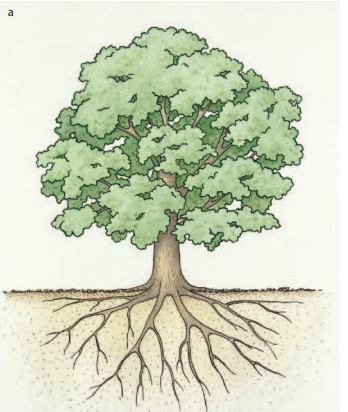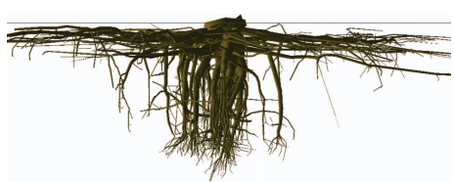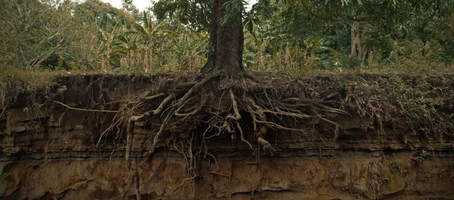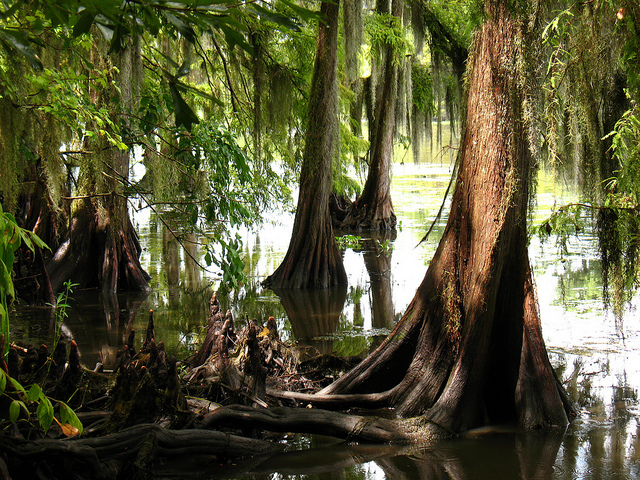Authored by: Tristan Moore
|
During a walk around your neighborhood, you might have noticed some trees growing around in yards or parks. You see many branches full of leaves displaying a massive canopy before you. As you gaze upon the tree, have you ever stopped to think about what might actually be going on with tree roots underneath the soil surface? Is the tree rooting system just as complex as the above ground branches?
It is often thought that tree roots mirror the above ground growth of the tree (see figure 1). Some think that if the tree consists of many branches, there must be just as many roots to support the tree underneath, right? This misconception is still widely believed because most people do not know what tree roots actually look like, since they are hidden under the soil surface (11). Another misconception about tree roots, is that trees have a dominant taproot that penetrates deep below the soil surface, however, taproots are the first initial root that forms from the seed coat and is generally short lived (11) (see figure 2). Knowing what roots are, how they grow, and the impact on public safety will help paint a picture to what is really going on underneath the soil surface. |
Figure 1. Example of the misconception that tree roots mirror the extent of the above ground growth in trees (2).
Figure 2. Initial taproot sprouting from seed coat (7).
|
What are roots?
Tree roots are an important part of the tree that lies below the soil surface, that provides water, minerals, and support for the tree (4). Roots grow from the cellular tissue of the root tips, often called meristematic tissue, powered by sugars that were created from the leaves via photosynthesis (4). Roots grow and expand through soil pores eventually supplying the tree with the oxygen, water, and the minerals it needs to survive (4). Stability and support, energy reserves, hormone synthesis, and providing oxygen, water, and minerals to the tree are the main functions of tree roots (4). Roots play a very important role in the life of a tree, but how far do they really grow?
Tree roots are an important part of the tree that lies below the soil surface, that provides water, minerals, and support for the tree (4). Roots grow from the cellular tissue of the root tips, often called meristematic tissue, powered by sugars that were created from the leaves via photosynthesis (4). Roots grow and expand through soil pores eventually supplying the tree with the oxygen, water, and the minerals it needs to survive (4). Stability and support, energy reserves, hormone synthesis, and providing oxygen, water, and minerals to the tree are the main functions of tree roots (4). Roots play a very important role in the life of a tree, but how far do they really grow?
|
Rooting Depth and Spread
Tree roots tend to grow in the upper 36 inches of soil and can grow well beyond the distance (up to 1.7 times the diameter) of the canopy, rather than rooting deep or mirroring the above ground growth of the tree (1). Most of the dominant tree roots run laterally near the soil surface to stay in better contact with water that falls on the soil surface (see figure 3) (4). Tree root depth can be influenced by different soil types in both positive and negative ways. If there is high clay content, there is less space in between each soil particle resulting in less oxygen, making it harder for roots to penetrate (2). Making clay soils much better about retaining water (2). Sandier soils have more space for oxygen and allows tree roots to grow more easily, but sand does not hold water as well as clay (2). Since sandy soils drain water faster than clay or silt soils, tree roots can tend to grow deeper (2). Compaction and lack of oxygen or water will inhibit root growth (2). Having a loamy (soil mixture of sand, silt, and clay), well drained, nutrient rich soil is the ideal growing medium for trees and their roots (see figure 4) (2). The pH (acidity), temperature, moisture, aeration (air between soil particles), compaction, or any harmful minerals can halt or change the rate at which tree roots can grow (4). Some trees grow well in one soil type, while other trees grow best on other soil types. This is due to each tree species having been adapted or evolved to the ecoregion (dry, humid, mountainous terrain, etc.) in which they are found naturally growing (4). Different types of trees can tolerate different types of conditions, for instance, some trees, like the bald cypress (Taxodium distichum) can thrive in soils that are more saturated with water and others prefer drier environments (see figure 5). If soil conditions (pH, aeration, moisture, etc.) are good, most tree roots will thrive and grow well providing sound structural support and energy for the tree (5). Some soils contain big pieces solid rocks or concrete that the roots have to grow around and cannot penetrate (2). This can inhibit the depth or spread of the root system of the tree by obstructing root paths; causing issues with tree stability (2). This brings up issues with tree stability and a concern for public safety. |
Figure 3. A graphical reconstruction of root depth and spread with the use of digital data (3).
Figure 4. Tree roots growing in top meter of soil profile with many soil horizons (6).
Figure 5. Bald cypress (Taxoidum distichum) growing in saturated soil conditions (8).
|
|
Why Do We Care?
Tree roots help support the entire weight of the tree and all of the surrounding environmental conditions that affect it (10). Storms, high winds, freezing temperatures, and other environmental conditions can cause potential issues with trees and public safety (10). Branches could break off or entire trees can fall and strike any person, car, or building in its path (10). If the trees have poor stability from lack of room for root growth, wind for instance, can throw entire trees over revealing the structure of the roots, often called a root plate (see figure 6) (10). By allowing tree roots to grow in a fashion where they can adequately grow will help mitigate the potential dangers of falling trees (9). If we know how a tree tends to root, we can predict where the roots will tend to go. By knowing this information, we can plan for avoiding root interactions with underground utilities, foundations, sidewalks and sewer lines (9). Planting trees away from these obstructions will increase tree stability and decrease the amount of maintenance required for said obstructions (9). If trees are planted too close to streets, sidewalks, or any other foundations, there could be a good chance of damage to these obstructions or a weakened tree stability from lack of room for their roots (9). Some think that tree roots are the main cause to lifting or cracking of sidewalks and streets, but that is not generally the case. Tree roots expose pre-existing cracks or fissures and make them worse; tree roots do not actually crack the concrete itself (9). Treatments such as: raising sidewalks and streets supported by Silva Cells to allow root growth underneath concrete; routing sidewalks and paths away from trees and their roots; using rubber or more flexible materials instead of concrete; less compacted soil structure under or away from streets to promote root growth instead of growing under concrete surface, are all ways to help mitigate potential root interactions and allow for good tree stability (9). |
Figure 6. Wind thrown tree exposing the tree root plate, likely caused by limited root growth from the rock obstructions in the soil (12).
|
Summary
Even though trees can display many branches and above ground growth, the roots will more likely be within the top 36 inches of top soil instead of deep rooting depths (1). The misconception mostly comes from people being uninformed or unfamiliar with what tree roots actually look like, because tree roots are not as visible as the above ground growth (11). Depth is controlled by soil factors; trees root deeply when they can given the right soil characteristics (loamy, well drained, nutrient rich) (2). All trees form a tap root which is usually short lived and the myth of trees mirroring the above ground growth tends to be unrealistic (11). By knowing the extent to which roots can grow, we are better able to mitigate any potential issues regarding public safety and help ensure a sturdy tree with a good rooting structure (9).
Even though trees can display many branches and above ground growth, the roots will more likely be within the top 36 inches of top soil instead of deep rooting depths (1). The misconception mostly comes from people being uninformed or unfamiliar with what tree roots actually look like, because tree roots are not as visible as the above ground growth (11). Depth is controlled by soil factors; trees root deeply when they can given the right soil characteristics (loamy, well drained, nutrient rich) (2). All trees form a tap root which is usually short lived and the myth of trees mirroring the above ground growth tends to be unrealistic (11). By knowing the extent to which roots can grow, we are better able to mitigate any potential issues regarding public safety and help ensure a sturdy tree with a good rooting structure (9).
References
1. Identifying roots of northern hardwood species: patterns with diameter and depth. Yaney, R.; Fisk, M.; Fahey, T.; Cleavitt, N.; & Park, B. 2008, Canadian Journal of Forest Research, Vol. 38, pp. 2862-2869.
2. The Influence of Soils and Species on Tree Root Depth. Crow, P. 2005, Forestry Commission, pp. 1-8.
3. Towards developmental modeling of tree root systems. Tobin, B. 2007, Plant Biosystems, Vol. 141, No. 3, pp. 481-501.
4. Physiology of Woody Plants. Pallardy, S. 2008, Elsevier Inc., Vol. 3, pp. 28-35;68-72.
5. Root System Morphology Influences Lateral Stability of Swietenia mahagoni. Gilman, E. & Harchick, C. 2014, Arboriculture & Urban Forestry, Vol. 40, pp. 27-35.
6. Forestkeepers. (2016). Tree Roots and Soil. Image. Retrieved from:
https://environment.arlingtonva.us/2016/02/designing-a-forest-from-the-ground-up/
7. Landscapeonline. (2015). Germinating acorn with tap root. Image. Retrieved from:
http://www.vegetariat.com/2015/12/plant-guild-5-mining-plants/
8. Vilseskogan. (2013). Bald cypress swamps with Spanish moss. Image. Retrieved from:
https://statesymbolsusa.org/symbol-official-item/louisiana/state-tree/bald-cypress
9. Trees, Roots and Infrastructure: Designing Tree Openings. Urban, J. 2016, International Society of Arboriculture, Vol. 25, No. 3, pp. 26-29.
10. When Winds and Trees Collide: The Influence of Sidewalk Repair, Trunk Flare, and Wind-Loading Events on Boulevard Tree Failures. Johnson, G.
2016, International Society of Arboriculture, Vol. 23, No. 6, pp. 49-53.
11. Getting to the Root of the Problem. Vavrek, R. 2013, United States Golf Association, Vol. 51, No. 7, pp. 1-3.
12. Vasiloff, S. (1997). Soil defects causing wind thrown trees. Image. Retrieved from:
https://www.fs.fed.us/r3/resources/health/field-guide/nid/windthrow.shtml
1. Identifying roots of northern hardwood species: patterns with diameter and depth. Yaney, R.; Fisk, M.; Fahey, T.; Cleavitt, N.; & Park, B. 2008, Canadian Journal of Forest Research, Vol. 38, pp. 2862-2869.
2. The Influence of Soils and Species on Tree Root Depth. Crow, P. 2005, Forestry Commission, pp. 1-8.
3. Towards developmental modeling of tree root systems. Tobin, B. 2007, Plant Biosystems, Vol. 141, No. 3, pp. 481-501.
4. Physiology of Woody Plants. Pallardy, S. 2008, Elsevier Inc., Vol. 3, pp. 28-35;68-72.
5. Root System Morphology Influences Lateral Stability of Swietenia mahagoni. Gilman, E. & Harchick, C. 2014, Arboriculture & Urban Forestry, Vol. 40, pp. 27-35.
6. Forestkeepers. (2016). Tree Roots and Soil. Image. Retrieved from:
https://environment.arlingtonva.us/2016/02/designing-a-forest-from-the-ground-up/
7. Landscapeonline. (2015). Germinating acorn with tap root. Image. Retrieved from:
http://www.vegetariat.com/2015/12/plant-guild-5-mining-plants/
8. Vilseskogan. (2013). Bald cypress swamps with Spanish moss. Image. Retrieved from:
https://statesymbolsusa.org/symbol-official-item/louisiana/state-tree/bald-cypress
9. Trees, Roots and Infrastructure: Designing Tree Openings. Urban, J. 2016, International Society of Arboriculture, Vol. 25, No. 3, pp. 26-29.
10. When Winds and Trees Collide: The Influence of Sidewalk Repair, Trunk Flare, and Wind-Loading Events on Boulevard Tree Failures. Johnson, G.
2016, International Society of Arboriculture, Vol. 23, No. 6, pp. 49-53.
11. Getting to the Root of the Problem. Vavrek, R. 2013, United States Golf Association, Vol. 51, No. 7, pp. 1-3.
12. Vasiloff, S. (1997). Soil defects causing wind thrown trees. Image. Retrieved from:
https://www.fs.fed.us/r3/resources/health/field-guide/nid/windthrow.shtml






